Does Your Dog Have Separation Anxiety? Acupressure Can Help!

Separation anxiety is common in dogs, and is even more of an issue now as people head out into the world again after almost two years of pandemic restrictions. Find out how acupressure can help ease your dog’s fear of being left alone.
Dogs are deeply pack-oriented, so canine separation anxiety is a common problem. And thanks to fallout from the pandemic, more dogs than ever are experiencing separation anxiety as they adjust from having their people home all the time, to being left alone more often again. From your dog’s perspective, when you walk out the door, her food provider, protector, and source-of-comfort pack member has abandoned her. This can be tremendously upsetting to her, and may cause her to act out. Luckily, there are many ways to help ease canine separation anxiety, including the acupressure sessions outlined in this article.
CHINESE MEDICINE APPROACH — 4 TYPES OF SEPARATION ANXIETY
When a dog is experiencing separation anxiety, it happens for a reason. It’s up to us to figure out what that reason is so we can target the source and help resolve the dog’s painful reaction and sense of abandonment. Rather than lump all separation anxiety cases together, Chinese medicine strives to identify the root of the individual’s anxiety. We want to understand which emotion is at play for each dog. There are at least four different types of separation anxiety that stem from different organs in the dog’s body.
Fast fact: According to Chinese Medicine, each organ is associated with a particular emotion.
The dog’s behavior gives us a clue as to which organ is not in balance. Once we understand which organ it is, we can effectively address the root cause of his anxiety and provide an acupressure-massage session specifically for that dog. The intent is to balance the affected organ by reestablishing the harmonious and nourishing flow of energy.
1. Fear-based separation anxiety
The fear-based dog is extremely scared of being left by his guardian. He feels he has nothing left to lose; his pain cuts so deeply into his core sense of existence that he is willing to die to relieve it. Dogs are predatory in nature, and the fear-based animal can become aggressive to other pack members when left. Fear-based anxiety can lead to fear-aggression, a dangerous situation.
An integrative strategy is needed to help these poor dogs.
 Fast fact: In Chinese Medicine, the Kidney is associated
Fast fact: In Chinese Medicine, the Kidney is associated
with fear.
When it’s safe to work with the dog, offering an acupressure session that focuses on calming and balancing his Kidney energy will greatly reduce his level of fear. The more often you can offer the Fear-Based Anxiety Session, the better, especially initially.
 2. Timidity-based separation anxiety
2. Timidity-based separation anxiety
The timid dog appears insecure; he cowers, his tail is tucked under him, and he wants to hide or run away. This behavior indicates he doesn’t feel he belongs on this Earth. His sense of self depends on how and where he fits into the pack. When an important pack member leaves the house, this dog’s anxiety level can rise exponentially.
Fast fact: When left to his own devices, the timid dog is apt to eat your favorite slippers or gnaw on a chair leg.
According to Chinese pathology, using specific acupressure points and techniques known to balance the Stomach and Spleen will help the dog with timidity-based anxiety. The intent in offering this acupressure session is to help the dog feel more grounded and well-nourished, which in turn enhances his self-confidence. We want this dog to be capable of feeling comfortable and confident on his own.
 3. Emotionally chaotic-based separation anxiety
3. Emotionally chaotic-based separation anxiety
This is the dog that experiences emotional chaos and is unable to settle if her human is not present. Her whole world is thrown into chaos when her special human disappears. She wanders around and can become irritable.
Fast fact: Some dogs spin in circles when they experience
this type of generalized anxiety.
We can look to the Liver to help reduce this dog’s general stress level, because the Liver is responsible for balancing all the emotions. An hour before you leave, offering an acupressure session can make a huge difference in how the generally anxious dog functions and feels once you are gone.
 4. Defenselessness-based separation anxiety
4. Defenselessness-based separation anxiety
This dog feels defenseless and needs your constant protection. His anxiety increases when he feels threatened and does not have what it takes to fend for himself. Being in a pack is the only defense this dog thinks he has. His human will protect him from danger that he doesn’t feel equipped to deal with himself.
Fast fact: A young puppy, an older dog, or an injured or sick dog can feel very vulnerable when left alone.
 A comforting Chinese massage technique can be used to support the defenseless dog. Place your hand flat on the dog’s neck and stroke down his back off the midline, tracing along the Bladder meridian. Trace the Bladder meridian three times on each side of the dog. Go slowly, but with clear intent and gentle firmness. This technique is very soothing and calming. Finish with gently scratching the Bai Hui point on the midline of the dog’s sacrum.
A comforting Chinese massage technique can be used to support the defenseless dog. Place your hand flat on the dog’s neck and stroke down his back off the midline, tracing along the Bladder meridian. Trace the Bladder meridian three times on each side of the dog. Go slowly, but with clear intent and gentle firmness. This technique is very soothing and calming. Finish with gently scratching the Bai Hui point on the midline of the dog’s sacrum.
Separation anxiety is painful for a dog — and for us. These dogs literally feel their survival is at stake when they are not part of a pack. The good news is that acupressure-massage, combined with other supportive approaches, can manage and hopefully resolve your dog’s anxiety.



